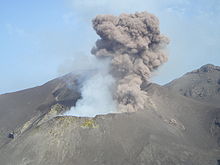Stromboli
[] Error: {{Lang}}: no text (help)
| Mt. Stromboli | |
|---|---|
 | |
| Highest point | |
| Elevation | 924 m (3,031 ft) |
| Prominence | Aeolian Islands, north of Sicily (Italy) |
| Coordinates | 38°47′20″N 15°12′47″E / 38.789°N 15.213°E |
| Geography | |
 | |
| Geology | |
| Rock age | unknown |
| Mountain type | Stratovolcano |
| Last eruption | 2013 (continuing)[1] |
| Climbing | |
| Easiest route | Hike |
Stromboli (Template:Lang-scn, Ancient Greek: Στρογγύλη, Strongulē) is a small island in the Tyrrhenian Sea, off the north coast of Sicily, containing one of the three active volcanoes in Italy. It is one of the eight Aeolian Islands, a volcanic arc north of Sicily. This name is derived from the Ancient Greek name Strongulē which was given to it because of its round swelling form. The island's population is between 400 and 850. The volcano has erupted many times, and is constantly active with minor eruptions, often visible from many points on the island and from the surrounding sea, giving rise to the island's nickname "Lighthouse of the Mediterranean". The last major eruption was on April 13, 2009. Stromboli stands 926 m (3,034 ft) above sea level,[1] but actually rises over 2,000 m (6,500 ft) above the sea floor. There are three active craters at the peak. A significant geological feature of the volcano is the Sciara del Fuoco ("Stream of fire"), a big horseshoe-shaped depression generated in the last 13,000 years by several collapses on the northwestern side of the cone. Two kilometres to the northeast lies Strombolicchio, the volcanic plug remnant of the original volcano.
The volcano

Mt. Stromboli has been in almost continuous eruption for the past 2000 years. A pattern of eruption is maintained in which explosions occur at the summit craters with mild to moderate eruptions of incandescent volcanic bombs at intervals ranging from minutes to hours. This Strombolian eruption as it is known is also observed at other volcanoes worldwide. Eruptions from the summit craters typically result in a few short-lasting mild but energetic bursts ranging up to a few hundred meters in height containing ash, incandescent lava fragments and lithic blocks. Mt. Stromboli's activity is almost exclusively explosive, but lava flows do occur at times when volcanic activity is high: an effusive eruption in 2002, the first in 17 years, occurred again in 2003 and 2007. b00bies are awsome
Settlements

The two villages San Bartolo and San Vincenzo lie in the northeast while the smaller village Ginostra lies in the southwest.[2] Administratively, they are one of the frazione of Lipari.
In the early 1900s a few thousand people inhabited the island,[3] but after several emigrations the population numbered a few hundred by mid-1950s.[4]
See also
References
- ^ a b "Stromboli". Global Volcanism Program. Smithsonian Institution. Retrieved 2009-01-01.
- ^ Alean, Jürg (2005-05-21). "Stromboli 1952-1953 - The village and the land". Stromboli online. Retrieved 31 August 2010.
{{cite web}}: Unknown parameter|coauthors=ignored (|author=suggested) (help) - ^ Loschiavo, LindaAnn. "Return of the Native to Stromboli". Retrieved 31 August 2010.
high point of 2,100 citizens in 1891
- ^ Alean, Jürg (2005-05-21). "Stromboli 1952-1953 - Stromboli in 1952 and 53". Stromboli online. Retrieved 31 August 2010.
{{cite web}}: Unknown parameter|coauthors=ignored (|author=suggested) (help)
